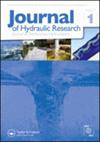后向台阶上自由表面流动的流体力学和湍流
IF 1.7
3区 工程技术
Q3 ENGINEERING, CIVIL
引用次数: 0
摘要
[摘要]通过对后台阶明渠水流的三次大涡模拟,研究了淹没对台阶下游湍流、水动力和水面变形的影响。水面的变形、再循环带的范围以及剪切层的强度都是相对淹没的函数。台阶下游的所有流动都表现出较高的湍流剪切应力水平,并包含大量的湍流动能。瞬时流动的特征是台阶后面的滚子和从剪切层脱落的马蹄形漩涡,后者被平流到水面,在那里它们引起变形。结果表明,这些涡可以产生于分划流线上的任意位置;然而,它们所含的能量越接近它们产生的平均附着位置。关键词:后向无台阶面大涡模拟相对淹没湍流致谢所有模拟均在伦敦大学学院Kathleen超级计算机上进行。披露声明作者未报告潜在的利益冲突。NotationAr=通道宽度-步高比(-)Cf=皮肤摩擦系数(-)Cp=压力系数(-)Er=膨胀比(-)Fr=弗劳德数(-)f=频率(Hz)f=浸没边界点的体积力(N m−3)g=重力加速度(m s−2)h=步高(m)h1=上游深度(m)h2=下游深度(m)K=湍流动能(m2 s−2)Lx=计算流向长度(m)Ly=计算跨向宽度(m)Lz=计算壁法向高度(m)p=压力(Pa)Re=体积雷诺数(-)Reh=阶跃高度雷诺数(-)Reτ=摩擦雷诺数(-)Ruu=u-速度自相关(-)Rvv=v-速度自相关(-)S=浸没(-)St=斯特罗哈数(-)t=倍(S)u=过滤分解速度场(m S−1)u¯=时间平均流速度(m S−1)- u ' w '¯=时间平均雷诺剪应力(m S−2)Umax=最大时间平均流速度(m S−1)Um1=上游空间平均平均速度(m S−1)Um2=下游空间平均平均速度(m S−1s−1)XR=再附着长度(m)Γ=气液界面(-)λ =湍流动能耗散(m2 s−3)ν=运动粘度(m2 s−1)ρ=液体密度(kg m−3)τSGS=亚网格尺度应力张量(-)τw=壁面剪切应力(Pa) φ =水平集距离函数(-)ψ=归一化流函数(-)Ωgas=气域(-)Ωliquid=液域(-)附加信息资助本文的工作由EPSRC支持,项目编号为EP/R022135/1。第三作者是EP/R022135/1资助的博士后,第一作者是伦敦大学学院土木、环境与测绘工程系资助的博士后。本文章由计算机程序翻译,如有差异,请以英文原文为准。
Hydrodynamics and turbulence of free-surface flow over a backward-facing step
ABSTRACTThree large-eddy simulations of open channel flow over a backward-facing step are performed to investigate the effect of submergence on the turbulence, hydrodynamics, and water surface deformation downstream of the step. The deformation of the water surface, the extent of the recirculation zone as well as the strength of the shear layer are a function of relative submergence. All flows downstream of the step exhibit elevated levels of turbulent shear stress and contain significant amounts of turbulent kinetic energy. The instantaneous flow features rollers immediately behind the step and horseshoe-shaped vortices shed from the shear layer, the latter being advected towards the water surface where they cause deformations. It is shown that these vortices can originate from any location along the dividing streamline; however, they contain more energy the closer to the mean attachment location they originate.Keywords: Backward-facing stepfree surfacelarge-eddy simulationrelative submergenceturbulence AcknowledgementsAll simulations were performed on UCL's supercomputer Kathleen.Disclosure statementNo potential conflict of interest was reported by the author(s).NotationAr=channel-width-to-step-height-ratio (–)Cf=skin-friction coefficient (–)Cp=pressure coefficient (–)Er=expansion ratio (–)Fr=Froude number (–)f=frequency (Hz)f=volume force from immersed boundary points (N m−3)g=gravitational acceleration (m s−2)h=step height (m)h1=upstream depth (m)h2=downstream depth (m)K=turbulent kinetic energy (m2 s−2)Lx=computational streamwise length (m)Ly=computational spanwise width (m)Lz=computational wall-normal height (m)p=pressure (Pa)Re=bulk Reynolds number (–)Reh=step height Reynolds number (–)Reτ=friction Reynolds number (–)Ruu=u-velocity auto-correlation (–)Rvv=v-velocity auto-correlation (–)S=submergence (–)St=Strouhal number (–)t=times (s)u=filtered resolved velocity field (m s−1)u¯=time-averaged streamwise velocity (m s−1)−u′w′¯=time-averaged Reynolds shear stress (m s−2)Umax=maximum time-averaged streamwise velocity (m s−1)Um1=upstream spatially-averaged mean velocity (m s−1)Um2=downstream spatially-averaged mean velocity (m s−1)XR=reattachment length (m)Γ=interface between gas and liquid domains (–)ϵ=turbulent kinetic energy dissipation (m2 s−3)ν=kinematic viscosity (m2 s−1)ρ=density of liquid (kg m−3)τSGS=sub-grid scale stress tensor (–)τw=wall shear stress (Pa)ϕ=level set distance function (–)ψ=normalized streamfunction (–)Ωgas=gas domain (–)Ωliquid=liquid domain (–)Additional informationFundingThe work presented in this paper is supported by the EPSRC under project number EP/R022135/1. The third author is a postdoctoral fellow sponsored by EP/R022135/1 whereas the first author has been funded by UCL's Department of Civil, Environmental and Geomatic Engineering.
求助全文
通过发布文献求助,成功后即可免费获取论文全文。
去求助
来源期刊

Journal of Hydraulic Research
工程技术-工程:土木
CiteScore
4.90
自引率
4.30%
发文量
55
审稿时长
6.6 months
期刊介绍:
The Journal of Hydraulic Research (JHR) is the flagship journal of the International Association for Hydro-Environment Engineering and Research (IAHR). It publishes research papers in theoretical, experimental and computational hydraulics and fluid mechanics, particularly relating to rivers, lakes, estuaries, coasts, constructed waterways, and some internal flows such as pipe flows. To reflect current tendencies in water research, outcomes of interdisciplinary hydro-environment studies with a strong fluid mechanical component are especially invited. Although the preference is given to the fundamental issues, the papers focusing on important unconventional or emerging applications of broad interest are also welcome.
 求助内容:
求助内容: 应助结果提醒方式:
应助结果提醒方式:


